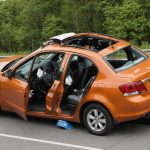Understanding the Challenges of Driving a Fully Loaded Minibus
Navigating the complexities of minibus safety becomes paramount when transporting passengers. A key factor is the weight considerations, as the mass of a fully loaded vehicle affects its dynamics significantly. Once a minibus reaches its full capacity, the vehicle’s weight distribution alters, impacting braking distance and steering response.
Driving challenges increase when the vehicle is at maximum passenger capacity. The added weight may slow acceleration and necessitate more powerful braking. Thus, it requires a driver to be acutely aware of the minibus’s limitations.
In the same genre : Boosting Convertible Safety: How a Roll Bar Can Make a Difference
Furthermore, drivers must comprehend vehicle dynamics under increased passenger load. This understanding is essential to maintain control, especially when turning corners or navigating through varying road conditions. The heavier the vehicle, the more pressure is placed on its mechanics, challenging the driver’s ability to maintain equilibrium.
To ensure effective passenger transport, understanding load distribution is vital. It’s not just about securing luggage, but also about balancing passengers within the minibus. Properly managing these aspects helps minimise the risks associated with transporting a large group. This knowledge equips drivers with the skills to handle the unique challenges of a fully loaded minibus, promoting safety for everyone on board.
Also to read : What specific safety features should I look for in an SUV versus a sedan?
Essential Pre-Trip Checks and Legal Requirements
Before embarking on any journey, conducting a pre-trip inspection is crucial for ensuring safety and regulatory compliance. This process involves examining vital components of the minibus, such as brakes, tyres, lights, and mirrors. A thorough check helps prevent breakdowns and accidents, ultimately making the trip safer for everyone on board.
Understanding the legal requirements for minibus operation is equally important. Operators must ensure that the vehicle complies with national road safety standards and holds valid licences and registrations. Compliance with these legal stipulations not only averts penalties but also ensures the vehicle is fit for purpose.
Documentation plays a significant role in this process. Proper maintenance of documents like insurance certificates, vehicle registration, and inspection certificates is mandatory. Keeping these in order helps verify that the vehicle adheres to all regulatory demands.
Failing to adhere to these checks and requirements may result in severe consequences, from fines to increased risk of mechanical failures. Therefore, consistent and detailed inspection routines, coupled with strict adherence to legal requirements, lay the foundation for a smooth and compliant journey. These steps are vital for both the operator’s peace of mind and the passengers’ safety.
Driving Techniques for a Fully Loaded Minibus
When operating a minibus, safe driving becomes crucial, especially with a full load onboard. Proper driving techniques are essential to ensure passenger safety and vehicle stability. Below are some insightful strategies to enhance your operational skills.
Managing Weight Distribution
Effective weight distribution contributes significantly to vehicle stability and control. Start by loading heavier items at the centre, ideally low to the vehicle floor. This reduces the risk of tipping by keeping the minibus’s centre of gravity low and balanced. Ensuring even distribution on both sides prevents adverse effects on steering.
Adjusting Driving Speed
With a fully loaded vehicle, adjusting your driving speed is paramount. Safe speed adjustments are necessary; extra load increases stopping distances and reduces acceleration capabilities. Brake earlier and more gently to account for these changes. Always consider the weight’s impact, especially when navigating curves or downhill passages.
Utilizing Advanced Driving Techniques
Advanced techniques can greatly improve safety and vehicle control. Emphasise smooth steering and braking to maintain stability and prevent abrupt movements. Introducing small steering inputs and gentle brake pressure can prevent skidding. Focus on maintaining momentum while ascending inclines, avoiding excessive speed that could destabilize the vehicle.
Implementing these strategies will enhance your driving techniques and contribute to a safer, more efficient journey.
Visibility and Awareness While Driving
Enhancing visibility and situational awareness are pivotal for safe driving, particularly with a fully loaded minibus. The first step in improving visibility is to adjust your mirrors and seat position correctly. Ensuring mirrors are set to minimise blind spots can significantly improve what you see around your vehicle. Position the seat so you can comfortably reach all controls and have a clear view of the road.
In terms of technique, maintaining situational awareness involves more than just looking around. Always scan the road ahead and frequently check your mirrors to stay informed about the traffic conditions around you. This proactive approach allows you to anticipate and react to potential hazards promptly.
Blind spots pose a unique challenge when driving larger vehicles like a minibus. Addressing them requires a combination of proper mirror adjustment and physical checks over the shoulder when changing lanes or merging. Utilising features such as wide-angle mirrors or blind-spot monitoring systems can also support these efforts.
By adhering to these safety tips and practices, drivers can improve their overall driving experience, ensuring both their safety and that of their passengers. Encouraging such habits builds confidence and can contribute to steadier, more efficient driving.
Stopping Distances and Braking Techniques
Understanding stopping distances is vital for safe minibus operation, especially when fully loaded. As vehicle weight increases, it directly impacts the stopping distance. Heavier vehicles require more time and distance to come to a complete stop, influencing the overall handling and safety.
Braking techniques for loaded minibuses should be adapted to accommodate the additional weight. One recommended method involves applying consistent, steady pressure on the brakes rather than abrupt braking. This technique helps maintain control and reduces the risk of skidding, especially in emergency procedures.
In an emergency, understanding effective emergency procedures is crucial. Drivers should be trained to remain calm and utilise techniques like threshold braking, which involves braking to the point just before the wheels lock up. This helps to maximise stopping efficiency without losing control or causing tire wear.
Anticipating stops is also essential. Knowing your vehicle’s braking distances and planning accordingly can prevent sudden stops, minimising the risk of accidents. Drivers should be aware of the road conditions, vehicle load, and distance from the vehicle in front to adjust their stopping distance effectively. This proactive approach ensures that minibuses operate safely, even in unexpected situations.
Emergency Procedures and Handling Breakdowns
It is critical to be well-prepared for potential emergencies, especially when dealing with vehicle breakdowns. Establishing a concrete plan before heading out can make a significant difference in ensuring everyone’s safety. Here’s how to handle such situations effectively.
To start, be aware of basic safety measures while on the road. Always carry an emergency kit stocked with essentials like first aid supplies, flares, and a flashlight.
If a vehicle breakdown occurs, it’s vital first to ensure that you and your passengers are safe. Safely maneuver the vehicle to the shoulder if possible and activate hazard lights to alert other drivers. Once parked, assess the situation while keeping everyone inside, unless you must exit due to danger like fire.
Passenger safety is paramount during emergencies. Keep calm and communicate clearly with everyone on board, informing them of the steps being taken. If assistance is needed, call for professional help.
Additionally, have a means of communication available, such as a charged mobile phone, to reach emergency services if the breakdown is beyond your ability to resolve. Prepare in advance, understand safety measures, and ensure everyone is aware of their role in an emergency.
Enhancing Passenger Safety and Comfort
Ensuring passenger safety and comfort during transit is of utmost importance for any transport service. Adhering to comprehensive comfort guidelines is essential. These guidelines include ensuring that seating arrangements are not overcrowded, providing adequate ventilation, and maintaining cleanliness. Regular checks and maintenance of safety equipment, such as seat belts and emergency exits, are critical to reinforcing passenger safety.
Communication with passengers regarding safety policies is crucial. Clear instructions on emergency procedures, both written and verbal, empower passengers to take appropriate actions when necessary. This also involves informing them about measures in place to ensure their comfort, such as availability of refreshments and restroom facilities.
Managing passenger behaviour is another key aspect. Encourage polite interaction among passengers and staff to promote a safe environment. Address disruptive behaviour promptly and discreetly to minimise discomfort for others. By implementing these travel tips, you can foster a pleasant experience for everyone on board.
In conclusion, balancing passenger safety and comfort involves diligent planning, effective communication, and active behaviour management. These steps contribute significantly to a successful transit experience, ensuring passengers feel secure and relaxed throughout their journey.











